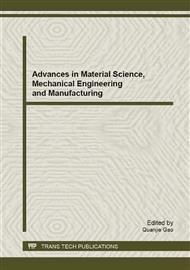[1]
D.K. Dwivedi. Adhesive wear behaviour of cast aluminium-silicon alloys: Overview. Materials and Design 31 (2010) 2517-2531.
DOI: 10.1016/j.matdes.2009.11.038
Google Scholar
[2]
Matsuura K, Kuudoh M, Kinoshita H, et. al. Precipitation of Si particles in a super-rapidly solidified Al-Si hypereutectic alloy. Materials Chemistry and Physics, 2003, (81): 393-395.
DOI: 10.1016/s0254-0584(03)00030-0
Google Scholar
[3]
Tae Kwon Ha, Park Ww-jin, Ahn Sangho, Young Wonchang. Fabrication of spray-formed hypereutectic Al-25Si alloy and its deformation behavior. Journal of Materials Processing Technology 2002, 6354: 1-2.
DOI: 10.1016/s0924-0136(02)00750-1
Google Scholar
[4]
Criado A J, Martinez J A, Calabres R. Growth of eutectic silicon from primarysilicon crystal in aluminum-silicon alloys. Scripta Meterialia. 1997, 36(1): 47-54.
DOI: 10.1016/s1359-6462(96)00332-6
Google Scholar
[5]
L.G. Hou, C. Cui, J.S. Zhanga. Optimizing microstructures of hypereutectic Al-Si alloys with high Fe content viaspray forming technique. Materials Science and Engineering A 527 (2010) 6400–6412.
DOI: 10.1016/j.msea.2010.06.066
Google Scholar
[6]
Min Zuo, Kun Jiang, Xiangfa Liu. Refinement of hypereutectic Al-Si alloy by a new Al-Zr-P master alloy. Journal of Alloys and Compounds 503 (2010) L26-L30.
DOI: 10.1016/j.jallcom.2010.05.017
Google Scholar
[7]
Feng Wanga, Jishan Zhang, Baiqing Xiong, Yongan Zhang. Effect of Fe and Mn additions on microstructure and mechanical properties of spray-deposited Al-20Si-3Cu-1Mg alloy. Materials Characterization 60(2009)384-388.
DOI: 10.1016/j.matchar.2008.10.011
Google Scholar
[8]
L.G. Hou, H. Cui, Y.H. Cai, J.S. Zhanga. Effect of (Mn + Cr) addition on the microstructure and thermal stability of spray-formed hypereutectic Al-Si alloys. Materials Science and Engineering A 527(2009) 85-92.
DOI: 10.1016/j.msea.2009.07.041
Google Scholar
[9]
Ching-Yi Yang, Sheng-Long Lee, Cheng-Kuo Lee, Jing-Chie Lin. Effects of Sr and Sb modifiers on the sliding wear behavior of A357 alloy under varying pressure and speed conditions. Wear 261 (2006) 1348-1358.
DOI: 10.1016/j.wear.2006.03.051
Google Scholar
[10]
W.X. Shi, B. Gao, G.F. Tu, S.W. Li. Effect of Nd on microstructure and wear resistance of hypereutectic Al-20%Si alloy. Journal of Alloys and Compounds 508 (2010) 480-485.
DOI: 10.1016/j.jallcom.2010.08.098
Google Scholar
[11]
Hongxia Genga, Haoran Geng, Xianying Xue. The effect of Ce on the hydrogen content and liquid structure of Al-16% Si melts. Materials Characterization 51 (2003) 29-33.
DOI: 10.1016/j.matchar.2003.09.007
Google Scholar
[12]
C.L. Xu, H.Y. Wang, Y.F. Yang, Hong-Ying Wang, Q.C. Jiang. Effect of La2O3 in the Al-P-Ti-TiC-La2O3 modifier on primary silicon in hypereutectic Al-Si alloys. Journal of Alloys and Compounds 421 (2006) 128-132.
DOI: 10.1016/j.jallcom.2005.11.034
Google Scholar
[13]
Yaping Wu, Shujun Wang, Hui Li, Xiangfa Liu. A new technique to modify hypereutectic Al-24%Si alloys by a Si-P master alloy. Journal of Alloys and Compounds 477 (2009) 139-144.
DOI: 10.1016/j.jallcom.2008.10.015
Google Scholar
[14]
M. Zuo, X.F. Liu, Q.Q. Sun, K. Jiang. Effect of rapid solidification on the microstructure and refining performance of an Al-Si-P master alloy. Journal of Materials Processing Technology 209 (2009) 5504-5508.
DOI: 10.1016/j.jmatprotec.2009.05.005
Google Scholar
[15]
L. Lua, A.K. Dahle. Effects of combined additions of Sr and AlTiB grain refiners in hypoeutectic Al-Si foundry alloys. Materials Science and Engineering A 435-436 (2006) 288-296.
DOI: 10.1016/j.msea.2006.07.081
Google Scholar
[16]
J. Espinoza-Cuadra, P. Gallegos-Acevedo, H. Mancha-Molinar, A. Picado. Effect of Sr and solidification conditions on characteristics of intermetallic in Al-Si 319 industrial alloys. Materials and Design 31 (2010) 343-356.
DOI: 10.1016/j.matdes.2009.06.017
Google Scholar
[17]
Zhonghua Zhong, Xiufang Bian, Yan Wang, Xiangfa Liu. Microstructures and modification performance of melt-spun Al-10 Sr alloy. Journal of Materials Science 37 (2002) 4473-4480.
Google Scholar


